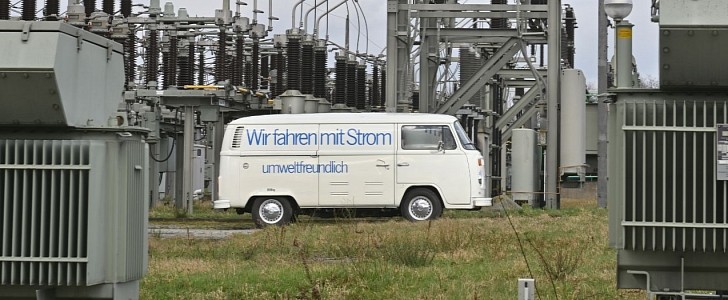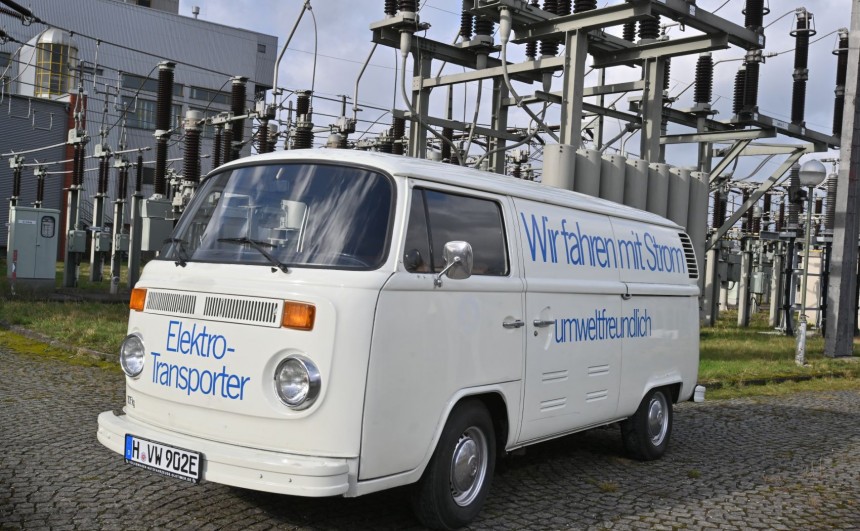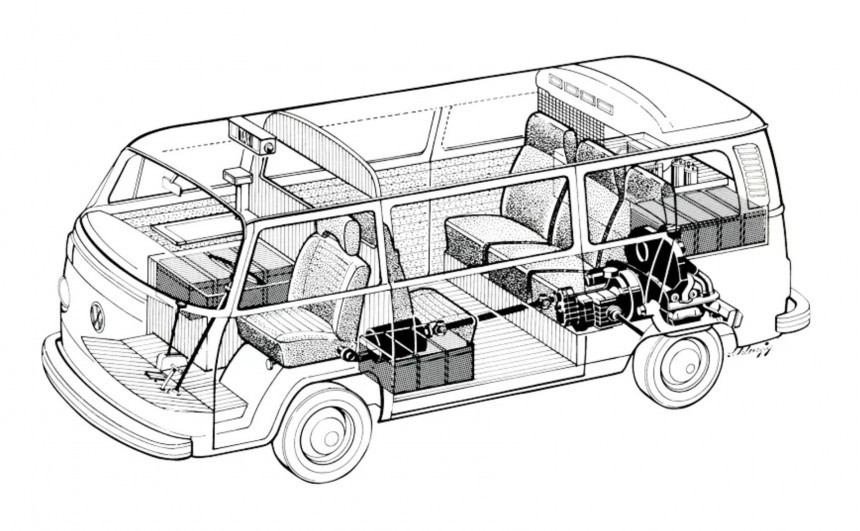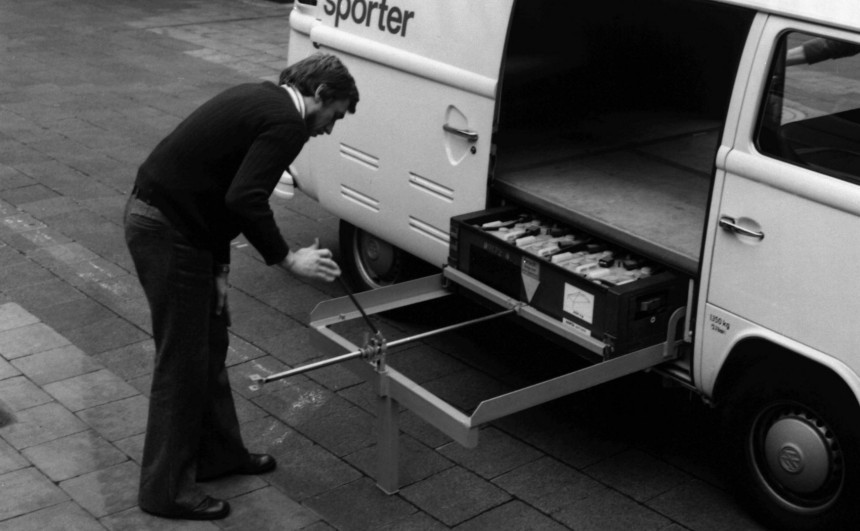While the ID. range which recently welcomed the Buzz is Volkswagen’s current fleet of electric vehicles, their efforts to replace internal combustion engines with electric power date back to the early 1970s.
Although minivans or microbuses have been pushed to the brink of extinction by SUVs in recent years, the German manufacturer decided to introduce an electrified reinterpretation of the wildly popular bus (or van) from the 1960s. Plans for this vehicle were revealed to the public several years ago, but earlier this month (March 2022), the production version was finally revealed. Called ID. Buzz, it will initially arrive in Europe for the 2023 model year in passenger and cargo versions, while the North American customers will be treated with a long-wheelbase, seven-seat variant in 2024.
Early reviews have been generally positive, with people praising its retro-inspired design. However, some have pointed out that the ID. Buzz is VW’s first fully electric van, a statement that couldn’t be farther from the truth.
Like all major automakers, the Germans have been experimenting with EVs for decades. In fact, the first fully-functional electric prototype was based on the chassis of the timeless T2, affectionately known in Germany as Bulli.
It all started in the late-1960s when it was commonly believed that the planet’s oil reserves would run out during the 1990s. Although this theory has turned out to be inaccurate (to say the least), it did motivate several manufacturers to experiment with alternative propulsion systems.
Volkswagen turned its attention to electric vehicles and established a research center dedicated to this mission. At the head of the small ten-man team, management appointed Dr. Adolf Kalberlah, an electro-chemist, and specialist in the field of battery research.
After several years of research, Dr. Kalberlah and his crew came up with an implementable design, but there was one big problem. Unlike today, when lithium-ion battery packs are reasonably compact and lightweight, back in the early-1970s, the lead-acid units available were large and heavy. Because of this, the only VW model that could accommodate the 1,874-pound (850 kg) experimental batteries, as well as the electric motor, was the T2.
To build the carmaker’s first electric vehicle, a conventional, second-generation camper van was taken off the assembly line and its flat-four was taken out. Extensive chassis modifications and reinforcements enabled the team to fit the electric motor conceived by Bosch behind the rear axle. For better weight distribution, the three batteries were mounted in the front, middle, and rear sections of the chassis. The first replaced the passenger front seat, the second was positioned under one of the rear seats, and the third sat inside the trunk.
The EV was completed in 1972, shortly after which it was put to a series of complex tests. Its motor could deliver a continuous output of 16 kW (22 hp) and a peak output of 32 kW (44 hp). The top speed didn’t exceed a modest 43.5 mph (70 kph), and it had a range of up to 28 miles (45 km).
Since the batteries took about 10 hours to charge when fully depleted, the engineers developed a system that made swapping all three packs relatively easy.
The idea behind this prototype was to offer both a cargo vehicle and a people carrier that could be used on short urban routes. In addition to charging stations, the team envisioned creating battery swap locations where owners could drive in and replace their depleted packs.
Work on the project continued between 1973 and 1975, with no less than 50 prototypes being built. Two years later, an optimized version of the vehicle dubbed Elektro Transporter went on sale under the slogan “Zero litters per 100 kilometers!”. Around 30 units capable of delivering up to 50 miles (80 km) on a full charge were built. Most of them were brought by local businesses that used their 1,763-pound (800 kg) payload capacity for cargo delivery purposes.
Although it was speculated that VW was attempting to partner with NASA, which was experimenting with more capable nickel-zinc batteries, the development of the Elektro Transporter ended in 1979. By this time, Dr. Kalberlah and his team had presented the company’s hybrid concept, a compact cab called CityTaxi, as well as an electrified prototype of the first-generation Golf.
During the following decades, the German manufacturer continued to fund research of electric powertrains, an effort that led to the e-Golf that debuted at the 2013 Frankfurt Motor Show. Only five years later, the first ID. concepts were created, followed by the series-production models that roam the streets today.
Early reviews have been generally positive, with people praising its retro-inspired design. However, some have pointed out that the ID. Buzz is VW’s first fully electric van, a statement that couldn’t be farther from the truth.
Like all major automakers, the Germans have been experimenting with EVs for decades. In fact, the first fully-functional electric prototype was based on the chassis of the timeless T2, affectionately known in Germany as Bulli.
Volkswagen turned its attention to electric vehicles and established a research center dedicated to this mission. At the head of the small ten-man team, management appointed Dr. Adolf Kalberlah, an electro-chemist, and specialist in the field of battery research.
After several years of research, Dr. Kalberlah and his crew came up with an implementable design, but there was one big problem. Unlike today, when lithium-ion battery packs are reasonably compact and lightweight, back in the early-1970s, the lead-acid units available were large and heavy. Because of this, the only VW model that could accommodate the 1,874-pound (850 kg) experimental batteries, as well as the electric motor, was the T2.
The EV was completed in 1972, shortly after which it was put to a series of complex tests. Its motor could deliver a continuous output of 16 kW (22 hp) and a peak output of 32 kW (44 hp). The top speed didn’t exceed a modest 43.5 mph (70 kph), and it had a range of up to 28 miles (45 km).
Since the batteries took about 10 hours to charge when fully depleted, the engineers developed a system that made swapping all three packs relatively easy.
Work on the project continued between 1973 and 1975, with no less than 50 prototypes being built. Two years later, an optimized version of the vehicle dubbed Elektro Transporter went on sale under the slogan “Zero litters per 100 kilometers!”. Around 30 units capable of delivering up to 50 miles (80 km) on a full charge were built. Most of them were brought by local businesses that used their 1,763-pound (800 kg) payload capacity for cargo delivery purposes.
Although it was speculated that VW was attempting to partner with NASA, which was experimenting with more capable nickel-zinc batteries, the development of the Elektro Transporter ended in 1979. By this time, Dr. Kalberlah and his team had presented the company’s hybrid concept, a compact cab called CityTaxi, as well as an electrified prototype of the first-generation Golf.
During the following decades, the German manufacturer continued to fund research of electric powertrains, an effort that led to the e-Golf that debuted at the 2013 Frankfurt Motor Show. Only five years later, the first ID. concepts were created, followed by the series-production models that roam the streets today.



















